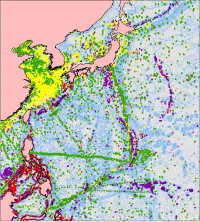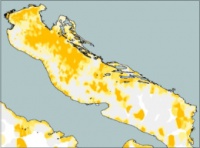Data:DBSEABED: Difference between revisions
m (corrected errors) |
m (Text replacement - "http://csdms.colorado.edu/wiki/" to "https://csdms.colorado.edu/wiki/") |
||
| (46 intermediate revisions by 2 users not shown) | |||
| Line 1: | Line 1: | ||
{{Data description | {{Data description | ||
|One-line data description=dbSEABED describes the materials and features of the global seafloor. | |One-line data description=dbSEABED describes the materials and features of the global seafloor. | ||
|Extended data description=dbSEABED is | |Extended data description=dbSEABED is a Database/GIS that deals with the materials and features of the seabed. It holds data describing about 2 million seafloor sites. dbSEABED deals with the grain size textures, strengths and porosities, carbon and carbonate compositions, colors, structural features, and grain components of the seafloor. | ||
The scope of dbSEABED is global, from shoreline and continental shelf to the abyssal floor, addressing terrigenous-, volcanic- and biogenic-derived materials in their rock and sediment forms. | |||
- | |||
The project supplies gridded outputs suitable for use in numerical models. The basic set of gridded parameters is: gravel, sand, mud (%), rock exposure (%), average grainsize and sorting (phi), carbonate (%). A specification of the parameters is given in the [http://walrus.wr.usgs.gov/usseabed/content.html usSEABED] web pages. dbSEABED uses the [http://commons.wikimedia.org/wiki/File:Wentworth-Grain-Size-Chart.pdf Wentworth grain size] classification and scale. | |||
A collection of ESRI ArcView 3.x and ArcGIS 9.x legends to this standard is available from this web address: GIS Legends. The format for delivery of gridded data from dbSEABED is the E.S.R.I. ASCII grid format, at finest 0.02 degrees cell size, with WGS 84 datums. The grid extents are grid-centred, i.e. ArcView 3.x format. | |||
'''Compiled coverages''': | |||
|Upload image dataset= | |||
|Caption dataset image=Example data | <table {{Prettytable}} class = "sortable" cellspacing="0" cellpadding="0" style="margin:0em 0em 0em 0;"> | ||
<tr><th {{H13}}>Area</th><th {{H13}}>Description</th><th {{H13}}>Data example</th> | |||
</tr> | |||
<tr> | |||
<td>East Asian Seas</td> | |||
<td>Details: ncols 900; nrows 1000; cellsize 0.05; NODATA_value -99; generated 27 Feb 2012</td> | |||
<td>[[File:Ttt_domnc_th.png|thumbnail|Gridded coverage for Bottom-Type Dominances]]</td> | |||
</tr> | |||
<tr> | |||
<td>Adriatic Sea</td> | |||
<td>This coverage served as a test-bed for gridding software and to support the EUROSTRATAFORM initiative. Details: ncols 386; nrows 286; xllcorner 12.0; yllcorner 40.2; cellsize 0.02; NODATA_value -99</td> | |||
<td>[[File:Adr sndT.jpg|thumbnail|Bottom-type Dominances]]</td> | |||
</tr> | |||
<tr> | |||
<td>Northern Gulf of Mexico ('GMF')</td> | |||
<td>The development of this coverage was funded by the USGS and Gulf States Marine Fisheries Commission. Details: ncols 891; nrows 383; xllcorner -98.19; yllcorner 23.36; cellsize 0.02; NODATA_value -99; dateline 2008</td> | |||
<td>[[File:Gmf datT.jpg|thumbnail|Point-data distribution]]</td> | |||
</tr> | |||
</table> | |||
|Upload image dataset=Domnc3D 29Sep2011.png | |||
|Caption dataset image=Example data product - Seafloor<br> classification, Northern Gulf of Mexico | |||
}} | }} | ||
{{Data format | {{Data format | ||
| Line 13: | Line 37: | ||
|Data origin=Measured | |Data origin=Measured | ||
|Data format=ASCII | |Data format=ASCII | ||
|Other data format=ESRI grid | |||
|Data resolution=Usually 0.02 deg | |||
|Data projection=WGS84 | |||
}} | }} | ||
{{Dataset coverage | {{Dataset coverage | ||
| Line 19: | Line 46: | ||
}} | }} | ||
{{Dataset availability | {{Dataset availability | ||
|Data download link=http:// | |Data download link=http://instaar.colorado.edu/~jenkinsc/dbseabed/coverage/ | ||
|Data source link=http://instaar.colorado.edu/~jenkinsc/dbseabed/ | |Data source link=http://instaar.colorado.edu/~jenkinsc/dbseabed/ | ||
}} | }} | ||
{{Data references | {{Data references | ||
|Key references dataset=Jenkins, C.J. 2010. Seafloor Substrates. INSTAAR, University of Colorado, Boulder CO USA. (URL: " | |Key references dataset=Cite as: Jenkins, C.J. 2010. Seafloor Substrates. INSTAAR, University of Colorado, Boulder CO USA. (URL: "https://csdms.colorado.edu/wiki/Data:DBSEABED"; Last edit 25Aug2013) | ||
}} | }} | ||
Latest revision as of 17:17, 19 February 2018
DBSEABED dataset information page
Short Description
| Example data product - Seafloor classification, Northern Gulf of Mexico |
Statement: dbSEABED describes the materials and features of the global seafloor.
Abstract: [[Extended data description::dbSEABED is a Database/GIS that deals with the materials and features of the seabed. It holds data describing about 2 million seafloor sites. dbSEABED deals with the grain size textures, strengths and porosities, carbon and carbonate compositions, colors, structural features, and grain components of the seafloor. The scope of dbSEABED is global, from shoreline and continental shelf to the abyssal floor, addressing terrigenous-, volcanic- and biogenic-derived materials in their rock and sediment forms.
- The project supplies gridded outputs suitable for use in numerical models. The basic set of gridded parameters is: gravel, sand, mud (%), rock exposure (%), average grainsize and sorting (phi), carbonate (%). A specification of the parameters is given in the usSEABED web pages. dbSEABED uses the Wentworth grain size classification and scale.
A collection of ESRI ArcView 3.x and ArcGIS 9.x legends to this standard is available from this web address: GIS Legends. The format for delivery of gridded data from dbSEABED is the E.S.R.I. ASCII grid format, at finest 0.02 degrees cell size, with WGS 84 datums. The grid extents are grid-centred, i.e. ArcView 3.x format.
Compiled coverages:
| Area | Description | Data example |
|---|---|---|
| East Asian Seas | Details: ncols 900; nrows 1000; cellsize 0.05; NODATA_value -99; generated 27 Feb 2012 | |
| Adriatic Sea | This coverage served as a test-bed for gridding software and to support the EUROSTRATAFORM initiative. Details: ncols 386; nrows 286; xllcorner 12.0; yllcorner 40.2; cellsize 0.02; NODATA_value -99 | |
| Northern Gulf of Mexico ('GMF') | The development of this coverage was funded by the USGS and Gulf States Marine Fisheries Commission. Details: ncols 891; nrows 383; xllcorner -98.19; yllcorner 23.36; cellsize 0.02; NODATA_value -99; dateline 2008 |
]]
Data format
| Data type: | Substrates |
| Data origin: | Measured |
| Data format: | ASCII |
| Other format: | ESRI grid |
| Data resolution: | Usually 0.02 deg |
| Datum: | WGS84 |
Data Coverage
Spatial data coverage: Global point source measurements
Temporal data coverage: Time averaged
Time period covered:
Availability
Download data: http://instaar.colorado.edu/~jenkinsc/dbseabed/coverage/
Data source: http://instaar.colorado.edu/~jenkinsc/dbseabed/
References
- Cite as: Jenkins, C.J. 2010. Seafloor Substrates. INSTAAR, University of Colorado, Boulder CO USA. (URL: "https://csdms.colorado.edu/wiki/Data:DBSEABED"; Last edit 25Aug2013)




